"What? He's Dead?" |
"Not any more." |
It may seen a bit of a stretch to start comparing Stuart Gordon to Orson Welles, but hear me out. Welles first came to fame producing and performing in adventurous works for the theatre, notably a production of Julius Caesar set in fascist Italy for the Mercury Theatre Company, which he co-founded with his close collaborator John Houseman. He eventually turned his talents to film directing, the technical aspects of which he learned on the move. His debut feature would go on to be held in such high esteem that it remains to this day the most celebrated film of his career, in spite of the number he subsequently directed. A simplistic summary, perhaps, but the basics are there. So what of Stuart Gordon? Well Gordon also first made his name producing adventurous works for the theatre, which famously included the world premiere of Sexual Perversity in Chicago, the play that launched the career of then newcomer David Mamet. It was performed by members of the Chicago Organic Theatre Company, which Gordon co-founded with his wife Carolyn Purdy-Gordon, a group whose alumni included Joe Mantegna and Dennis Franz. Gordon also later turned his talents to film directing, the technical aspects of which he learned on the move, and his first feature is held in such high regard that it remains the most celebrated film of his career, in spite of the number he subsequently directed.
Of course, few are going to claim that Re-Animator is as a groundbreaking or important a film as Citizen Kane (prove me wrong, horror fans!), but the career path above is one that has afflicted any number of young hopefuls who made a big splash with their first or breakthrough film. And despite the re-evaluation and championing of much of Welles' subsequent work, dial up his page on IMDb and just see which film his name is still primarily associated with. Now check out Stuart Gordon. Then try Alex Cox, Tobe Hooper, George A. Romero, Sam Mendes and Donald Cammell. Can you see a pattern emerging?
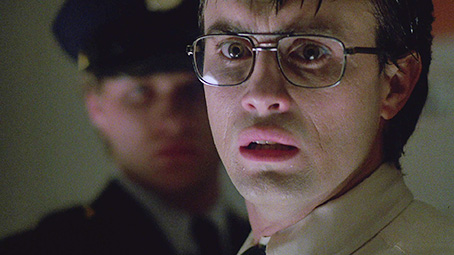
I don't mean to suggest that these fine people are not happy with their first films – Hooper, Cox, Romero, Gordon and Mendes still have very fond memories of making their debut features and hold them in high regard – but it must be a bit galling to have that one film quoted back at you in every review of your later work and every interview you give. It's something such directors eventually have to learn to live with – Gordon himself admits in the extra features on this very disc that, despite his subsequent work (he has accrued a further 18 directing credits and almost as many as writer and producer), he will always be known as Stuart 'Re-Animator' Gordon.
I covered the film in some detail when I reviewed the Double Disc Collector's Edition DVD from Starz Entertainment (Anchor Bay UK by another name) back in 2007, which you can read here. Indeed, if you read the whole thing then I'll be left with little to write about here, as this new Second Sight double-disc Blu-ray is in many ways an HD upgrade of that very release, with almost exactly the same extra features, most of which had previously appeared on the earlier American 2-disc DVD from Elite. The key difference, of course, is is how it looks...
Restored in 4K resolution by TLEFilms Film Restoration & Preservation Services in Berlin in 2013, the image here is not as spectacular as some other recent restorations of cult films of the period might lead you to expect. It's still a fine job, and has an instant advantage over the one on the Starz DVD by way of its first generation purity, the previous transfer having been a standard definition NTSC to PAL conversion. The higher resolution is clearly visible from the opening shot of the Zurich University Institute of Medicine, which is crisp enough to allow you to start counting how many bricks were used to build the front wall. The tonal range is also richer here and the image brighter, something that really hits home two shots later in the corridor interior, which looks positively gloomy in the DVD by comparison. With a few exceptions (usually night-time house exteriors), the shadow detail is far more forgiving on the new transfer, although there is still a slightly dour look to some of the imagery – hospital hallways are a favourite on this score – that appears to be an aspect of the film's set design and lighting choices, and just occasionally there is a shot where the earlier transfer feels a tad more vibrant. The curious thing is that, despite being framed 1.78:1 instead of the slightly windowboxed 1.82:1 of the DVD transfer, there is significantly more picture information on both sides and at the bottom edge of frame. Overall this is a solid HD restoration that noticeably improves on previous editions, but it never leaps from the screen, though again this may be very much down to the film's chosen aesthetic. No obvious edge enhancement is visible, and fine film grain is evident throughout.
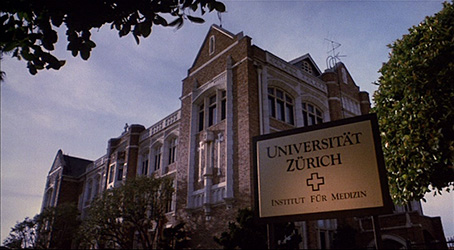
Compare the frame edges on the Starz DVD (above) and the Second Sight Blu-ray (below)

The screen grabs below are all from the Second Sight Blu-ray
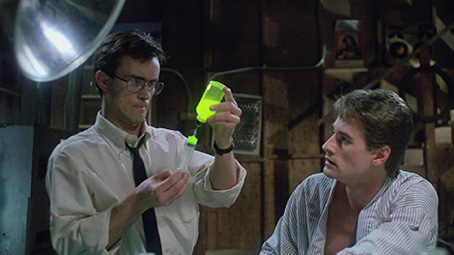
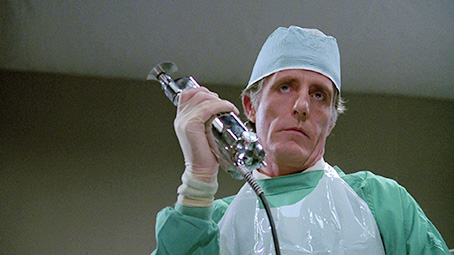
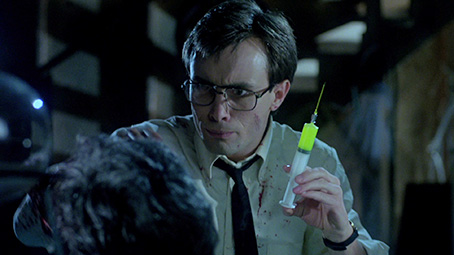

When it comes to soundtracks, you can choose between the original Linear PCM 2.0 stereo or a DTS-HD Master Audio 5.1. The stereo track is in a lot better shape than those of some genre films of the period and boasts a reasonable dynamic range, pleasing clarity, and a solid reproduction of Richard Band's score. It's seems unlikely that the 5.1 is a remix – there's nothing going on at the back of the room – and is essentially the same track with a sonically different feel. The music certainly seems livelier and fuller in 5.1, though the slight treble bias to the dialogue and effects on the stereo track is also present here.
Optional English SDH subtitles have also been included.
Where the extra features are the same as those on the previous Anchor Bay UK DVD, comments on them have been reproduced or adapted from that review. There is, however, one crucial new addition on Disc 2. The Unrated version of the film is on Disc 1.
Disc 1
Audio Commentary with director Stuart Gordon
An engrossing and information-packed track that covers a lot of ground, including Gordon's pre-film work as director of the Organic Theatre Group, the development of the Re-Animator script and film, the performances, the camerawork, the special effects (including West's glowing green serum), the decision to release the film unrated, and a whole load more. There are some nice anecdotes and memories too – my favourite surrounds the "You.....bastard!" line (you'll need to see the film to understand its amusing context), which so delighted actor Jim Belushi that he would call Gordon up just to rasp it down the phone at him.
Audio commentary with producer Brian Yuzna and actors Jeffrey Combs, Bruce Abbott, Barbara Crampton and Robert Sampson
A lively and enjoyable track in which the participants recall a number of amusing stories from the shoot, but spend more time poking fun at each other and their characters. Some find this sort of track irritating, but at their best they can be enjoyable and on rare occasions even hilarious (the commentaries on both Dog Soldiers and Severance are an absolute scream), and it's always nice to hear actors or filmmakers not taking themselves too seriously. This one certainly had me laughing out loud in places, with Combs both funny in himself and the most popular target of ribbing from others, from Abbott's "You're a fine person to talk about sick, Jeffrey," to Crampton's more direct "You did not! You're a big fat liar!"
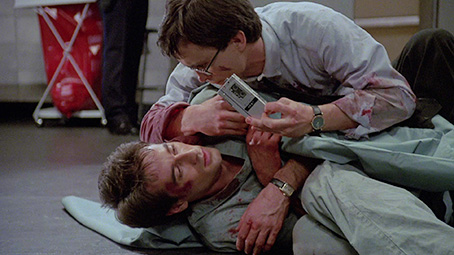
Disc 2
Re-Animator – Integral Version (104:56)
New to this release, and in the same fine shape as the unrated cut, is what has been labelled here the 'integral' version. A little explanation is probably required. When preparing the original unrated cut, director Stuart Gordon and producer Brian Yuzna chose to trim a number of scenes in order to up the pace and remove a hypnosis sub-plot that added a layer of weirdness that they believed the film no longer needed. When an 'R' rated version was being prepared for a later video release, the more extreme violence was trimmed and the deleted scenes were re-inserted to bulk up the running time. This excised material was included in extra features on the Starz DVD as extended scenes, and is available to view here in that very same form. The integral version includes all of the deleted material, but without the trims to the violence found in the R rated cut, making it the most complete version yet. The upside to this is that we get to see the deleted material in context, and this does help to clarify some plot points – we now know just why Dean Halsey reacts to negatively to Dan's news about West's experiments, for example – while the extra footage of Hill's impromptu meeting with West in Dan's basement really brings home how painful it is to West to be under Hill's control. What does come across clearly, though, is how negatively a couple of the sequences effect the pace – the extra bedroom conversation between Dan and Megan in particular almost puts the film on hold, though it does clear up a previous continuity issue. It should be noted that the re-insertion of this material has resulted in the loss of a few seconds just before the sequence in which Hill uses his severed head to hypnotise the straightjacketed Dean Halsey. The only audio option here is DTS-HD Master Audio 5.1.
Re-Animator Resurectus documentary (68:40)
The only extra that was new to the Starz release is a substantial one, and includes interviews with almost all of the main contributors from both sides of the camera. As a stand-alone feature it's informative, entertaining and well assembled, much in the manner of Callum Waddell's documentaries on the recent Arrow discs of horror favourites, but much the content is repeated elsewhere, particularly in Stuart Gordon's commentary track and the interviews on Disc 2.
Interview with Director Stuart Gordon and Producer Brian Yuzna (48:49)
Actually a filmed chat between the two men shot entirely from one angle (with some smoothly done reframing) that covers Gordon's pre-film stage work and the development and making of the film. Despite their coverage elsewhere, there's a lot more detail here and the two feed each other well.
Interview with Writer Dennis Paoli (10:40)
Paoli talks about the development of the story and script, as well as fellow writer William Norris's contribution. He does confirm that both he and Gordon are huge fans of Hammer films.
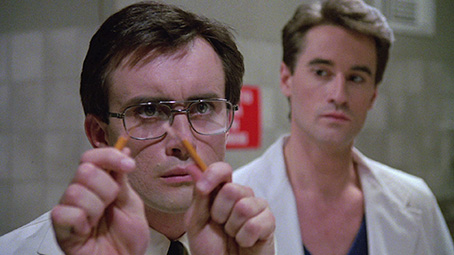
Interview with Composer Richard Band (14:43)
Inevitably Band talks about the development of the score, including the borrowing from Bernard Herrmann, whom he claims was originally supposed to be thanked on the end credits. Not all of his stories concur with those of the other contributors on the disc, particularly his suggestion that the filmmakers didn't realise that there was a layer of humour in the film until he pointed it out and suggested scoring it in a campy way. Seriously?
Music Discussion with Composer Richard Band (16:29)
A really interesting piece in which Band introduces a number of the tracks used in the film, which are then shown with the sequence in question but with all other sound muted, allowing you to fully appreciate how the music has been used. Good one. It does include the entire end credits sequence, though, which is no different here to how it plays on the film itself.
Interview with Fangoria Editor Tony Timpone (4:35)
Timpone looks back at his first viewing of the film and his hope that it would signal a revival of the old-style horror stars (it didn't, of course). He also recalls a competition the magazine ran that featured a rather unusual prop from the film as a prize.
Extended Scenes (21:22)
The deleted material that has been restored to the integral version, briefly topped and tailed with material from the scenes in which it originally sat. Seen in isolation, it's hard to appreciate whether these sequences would add to or detract from the unrated cut, and they are better appreciated as part of the integral version. There's quite a bit more of the hypnosis sub-plot discussed elsewhere ("Like this film needs a sub-plot!" exclaims Bruce Abbott on the second commentary track) and a further character complication that has West addicted to his own serum.
Deleted Scene (2:51)
The deleted dream sequence, cut in part because the filmmakers thought it didn't look like a dream at all, which until the end it doesn't. It has not been included in the integral cut.
Trailer (6:54)
The same theatrical trailer twice – the first is decent quality and framed 1.78:1, the second in rougher shape and framed 1.85:1 – is followed by 5 different TV spots, two with no film extracts, one of which appears to be for the unrated version. The TV spots try hard to sell the film as a serious scary horror, but the theatrical trailer at least seems aware of its humour.
Behind-the–Scenes Gallery (5:52)
A fast-moving rolling gallery of on-set stills, many of which are rather fun. Although this appears to have been distilled from the galleries on the Starz DVD, the images are larger and of a higher quality here.
Production Stills (2:07)
Less interesting than the above, but again of decent size and quality.
While it doesn't leap from the screen in the manner of some other HD restorations of cult genre films, the transfer on Second Sight's new Blu-ray is still, for the most part, a significant upgrade on the previous Starz Entertainment DVD release. That it has almost the exact same extras (minus PDFs of the screenplay and Lovecraft's original stories) may seem a little disappointing for those who own the earlier release, but this is still a terrific collection, and if they weren't on board we'd all be complaining. If you don't already own the DVD then this is a no-brainer – this is the one to buy. If you do then the picture upgrade and the inclusion of the integral version still make it a bit of a must for fans.
|